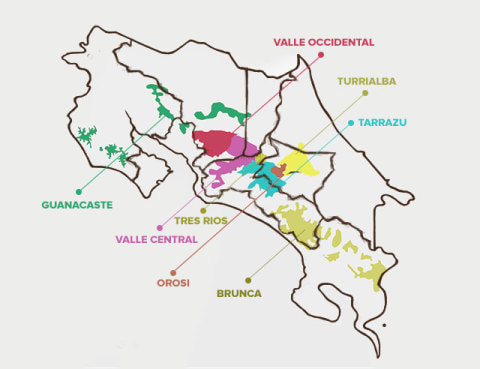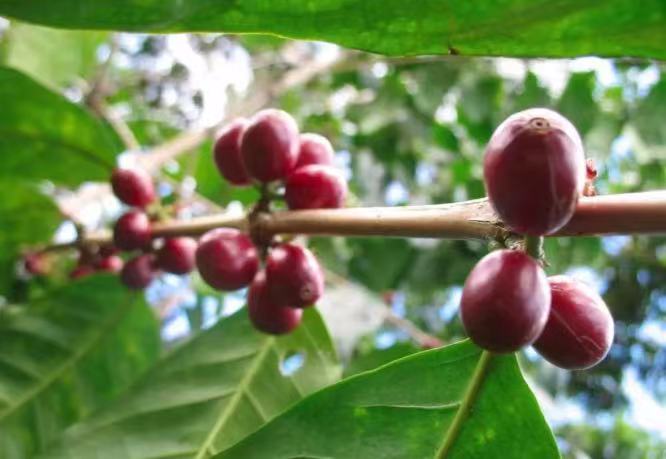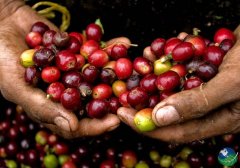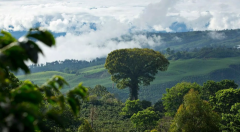A brief introduction to the multi-tower goddess manor in Costa Rica the story of multi-tower rose summer coffee beans and their flavor and taste characteristics
Coopedota, Costa Rica is located in the heart of Santa Maria de Dota's famous and rugged Tarrazu growing area, which is famous for its mineral-rich soil and ideal growing climate and for its award-winning coffee. The cooperative was founded in 1960 by 96 producers in the Dota Valley region and has since grown to have more than 800 members harvesting 65000 bushels of coffee each year. As can be seen from the photos below, during the peak harvest period, members of the cooperative will take their coffee and process it in various vehicles.

Before the establishment of Coopedota, coffee growers in the region knew little about production and sales. As there are no other factories in the area, producers are forced to sell cherries to dealers at unfavorable prices. Today, members bring their coffee to a shared wet mill in Santamaria and use their power as a cooperative to negotiate the sale of coffee at a fair price.
In addition to helping to promote the social economy of the region, Coopedota also focuses on environmental protection. All members strive to use environmentally friendly planting and processing technologies. As part of their commitment to local communities and the environment, cooperatives are involved in sustainable development, recycling programmes, renewable energy, reducing water consumption and reusing their own coffee products. In 2011, they were recognized as the world's first carbon-neutral coffee producer, an impressive achievement.
Coopedota is also involved in ecotourism, especially during the harvest season from November to March. The tour begins with processing plants and wet mills, where visitors can see the complete journey of coffee in its place of origin before visiting the roasting plant, where they can learn the basics and flavor characteristics of coffee roasting. In addition to wet mills and roasters, their facilities include an in-house coffee shop.
Glass features: aromas of black pepper and brown butter. Very sweet and juicy, red apple
Planting density is very high, high altitude growth, can hum good deep baking. Highlight the nuances of brightness and sweetness. Even if you darken the eyes and produce the taste and segmentation of chocolate, there will still be some personalized acidity in it.
In 1865, the dota area was known as Hogostaric Coffee, because the road extending from the capital to the dota Valley passed through the Tara Pearl producing area, so when COFA divided the producing area, it was called dota trazu. This area is a typical plateau topography, no matter the soil, temperature and humidity are the best choice for coffee planting conditions.

The Goddess Manor was founded in the 1960s, and the owner and Pachi serracin, now the hot father of the Panamanian summer, were good friends at that time. It was because of him that he began to grow a geisha. The Goddess Manor grows coffee in organic agriculture, uses native forests and fruit trees as shade, and uses fertilizer mixed with coffee cherry pulp and molasses. Fertile soil with high mineral content was added to neighboring mountain areas for microbial fermentation to prepare organic fertilizers to enhance the disease resistance of coffee plantation. it was also used for soil cultivation with earthworms in California and directly as the main source during the fertilizer application period. Coffee trees are mixed with a variety of coffee varieties. Always hand-select ripe red berries and strictly control the soaking and fermentation process. Develop a very unique wet treatment method, which does not ferment too much to achieve an excellent balance between clarity and complexity. Let its taste show better stability, show the special taste layer of geisha, it will really intoxicate people.
The rosy summer of the goddess manor on the front street has fresh aromas of wild ginger and grapefruit, grapefruit, blueberries, soft and round, cool tropical fruits, and the division of grapefruit in the aftertaste is very long-lasting and sour.
Important Notice :
前街咖啡 FrontStreet Coffee has moved to new addredd:
FrontStreet Coffee Address: 315,Donghua East Road,GuangZhou
Tel:020 38364473
- Prev

How about Costa Rican coffee with what traditional food? What kind of food do you drink coffee with?
Breakfast starts with a cup of hot coffee, and Costa Ricans like their coffee. The staple food in Costa Rica is rice, beans and vegetables, and they eat almost every meal. On their plates are the famous Gallo pinto, a mixture of rice and beans, as well as white bread, eggs, bananas and rich sour cream. For breakfast, you should know that most Central American coffee
- Next

Costa Rican Volcano Coffee effect of High altitude Volcanoes on the growth and Flavor of Coffee beans in Tarasu
Costa Rican Tarasu coffee grows in high-altitude volcanic soil, where cherries ripen more slowly, giving it a rich and rich flavor. Single-origin Tarrazu Estate coffee, known as one of the best coffee in the world, is roasted to medium color to retain its natural fullness, elegance and rich flavor. Certification: kosher certified Rain Forest Union
Related
- Detailed explanation of Jadeite planting Land in Panamanian Jadeite Manor introduction to the grading system of Jadeite competitive bidding, Red bid, Green bid and Rose Summer
- Story of Coffee planting in Brenka region of Costa Rica Stonehenge Manor anaerobic heavy honey treatment of flavor mouth
- What's on the barrel of Blue Mountain Coffee beans?
- Can American coffee also pull flowers? How to use hot American style to pull out a good-looking pattern?
- Can you make a cold extract with coffee beans? What is the right proportion for cold-extracted coffee formula?
- Indonesian PWN Gold Mandrine Coffee Origin Features Flavor How to Chong? Mandolin coffee is American.
- A brief introduction to the flavor characteristics of Brazilian yellow bourbon coffee beans
- What is the effect of different water quality on the flavor of cold-extracted coffee? What kind of water is best for brewing coffee?
- Why do you think of Rose Summer whenever you mention Panamanian coffee?
- Introduction to the characteristics of authentic blue mountain coffee bean producing areas? What is the CIB Coffee Authority in Jamaica?

